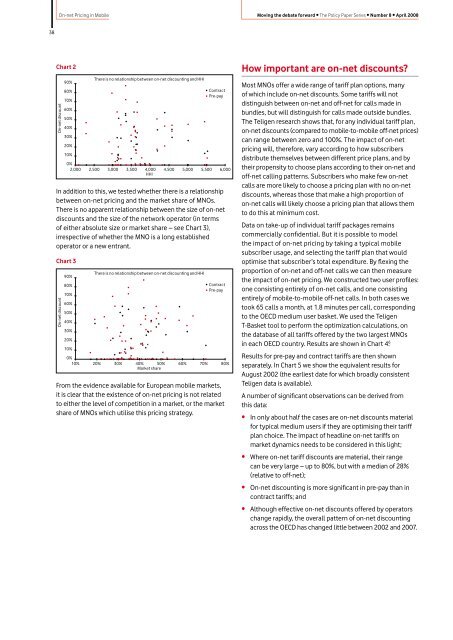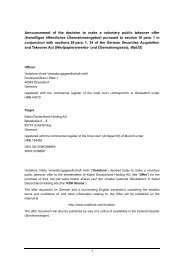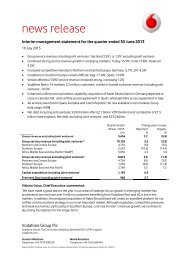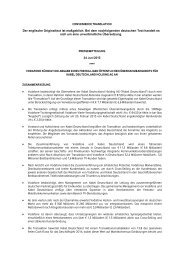You also want an ePaper? Increase the reach of your titles
YUMPU automatically turns print PDFs into web optimized ePapers that Google loves.
38<br />
On-net Pricing in Mobile Moving the debate forward • The Policy Paper Series • Number 8 • April 2008<br />
Chart 2<br />
On-net discount<br />
90%<br />
80%<br />
70%<br />
60%<br />
50%<br />
40%<br />
30%<br />
20%<br />
10%<br />
There is no relationship between on-net discounting and HHI<br />
Contract<br />
Pre-pay<br />
0%<br />
2,000 2,500 3,000 3,500 4,000<br />
HHI<br />
4,500 5,000 5,500 6,000<br />
In addition to this, we tested whether there is a relationship<br />
between on-net pricing and the market share of MNOs.<br />
There is no apparent relationship between the size of on-net<br />
discounts and the size of the network operator (in terms<br />
of either absolute size or market share – see Chart 3),<br />
irrespective of whether the MNO is a long established<br />
operator or a new entrant.<br />
Chart 3<br />
On-net discount<br />
90%<br />
80%<br />
70%<br />
60%<br />
50%<br />
40%<br />
30%<br />
20%<br />
10%<br />
There is no relationship between on-net discounting and HHI<br />
Contract<br />
Pre-pay<br />
0%<br />
10% 20% 30% 40% 50% 60% 70% 80%<br />
Market share<br />
From the evidence available for European mobile markets,<br />
it is clear that the existence of on-net pricing is not related<br />
to either the level of competition in a market, or the market<br />
share of MNOs which utilise this pricing strategy.<br />
How important are on-net discounts?<br />
Most MNOs offer a wide range of tariff plan options, many<br />
of which include on-net discounts. Some tariffs will not<br />
distinguish between on-net and off-net for calls made in<br />
bundles, but will distinguish for calls made outside bundles.<br />
The Teligen research shows that, for any individual tariff plan,<br />
on-net discounts (compared to mobile-to-mobile off-net prices)<br />
can range between zero and 100%. The impact of on-net<br />
pricing will, therefore, vary according to how subscribers<br />
distribute themselves between different price plans, and by<br />
their propensity to choose plans according to their on-net and<br />
off-net calling patterns. Subscribers who make few on-net<br />
calls are more likely to choose a pricing plan with no on-net<br />
discounts, whereas those that make a high proportion of<br />
on-net calls will likely choose a pricing plan that allows them<br />
to do this at minimum cost.<br />
Data on take-up of individual tariff packages remains<br />
commercially confidential. But it is possible to model<br />
the impact of on-net pricing by taking a typical mobile<br />
subscriber usage, and selecting the tariff plan that would<br />
optimise that subscriber’s total expenditure. By flexing the<br />
proportion of on-net and off-net calls we can then measure<br />
the impact of on-net pricing. We constructed two user profiles:<br />
one consisting entirely of on-net calls, and one consisting<br />
entirely of mobile-to-mobile off-net calls. In both cases we<br />
took 65 calls a month, at 1.8 minutes per call, corresponding<br />
to the OECD medium user basket. We used the Teligen<br />
T-Basket tool to perform the optimization calculations, on<br />
the database of all tariffs offered by the two largest MNOs<br />
in each OECD country. Results are shown in Chart 4. 6<br />
Results for pre-pay and contract tariffs are then shown<br />
separately. In Chart 5 we show the equivalent results for<br />
August 2002 (the earliest date for which broadly consistent<br />
Teligen data is available).<br />
A number of significant observations can be derived from<br />
this data:<br />
• In only about half the cases are on-net discounts material<br />
for typical medium users if they are optimising their tariff<br />
plan choice. The impact of headline on-net tariffs on<br />
market dynamics needs to be considered in this light;<br />
• Where on-net tariff discounts are material, their range<br />
can be very large – up to 80%, but with a median of 28%<br />
(relative to off-net);<br />
• On-net discounting is more significant in pre-pay than in<br />
contract tariffs; and<br />
• Although effective on-net discounts offered by operators<br />
change rapidly, the overall pattern of on-net discounting<br />
across the OECD has changed little between 2002 and 2007.

















